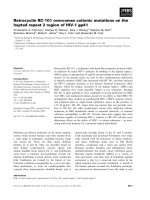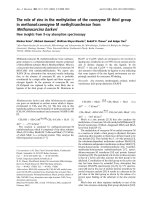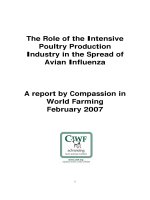Mutations within the quinolone resistance determining region in fluoroquinolone-resistant staphylococcus epidermidis recovered from different ocular isolates
Bạn đang xem bản rút gọn của tài liệu. Xem và tải ngay bản đầy đủ của tài liệu tại đây (553.71 KB, 11 trang )
Int.J.Curr.Microbiol.App.Sci (2018) 7(9): 1301-1311
International Journal of Current Microbiology and Applied Sciences
ISSN: 2319-7706 Volume 7 Number 09 (2018)
Journal homepage:
Original Research Article
/>
Mutations within the Quinolone Resistance Determining Region
in Fluoroquinolone-Resistant Staphylococcus epidermidis
Recovered from Different Ocular Isolates
Amrita Talukdar*, Kulandai Lily Therese and H. Nelofer Ali
L&T Microbiology Research Centre, Vision Research Foundation, Sankara Nethralaya,
Chennai, Tamil Nadu-600006, India
*Corresponding author
ABSTRACT
Keywords
Staphylococcus
epidermidis (S.
epidermidis),
Fluoroquinolone-resistant
Article Info
Accepted:
10 August 2018
Available Online:
10 September 2018
Staphylococcus epidermidis (S. epidermidis) is a common pathogen in ocular infection.
Mutations contribute to drug resistance. We intended to identify mutations in genes within
the quinolone resistance determining region (QRDR) of fluoroquinolone-resistant S.
epidermidis ocular isolates and to study their phenotypic and genotypic correlation. A total
of 50 phenotypically fluoroquinolones-resistant S. epidermidis isolates were studied.
Fluoroquinolones susceptibility was evaluated by Kirby- Bauer disk diffusion method.
Polymerase chain reaction (PCR) was optimized and applied followed by DNA sequencing
to detect mutations in gyrA, gyrB, parC and parE in the QRDR region among the
fluoroquinolone-resistant S. epidermidis isolates recovered from ocular specimens. The
majority of the samples (74%) were from conjunctival swabs (n = 37). gyrA, gyrB, parC,
and parE genes were detected in 47 samples (94%). gyrA gene (n = 47) was the most
common, followed by parE (n = 35), gyrB (n = 30) and parC (n = 28). In 25 isolates, all
four mutated genes were present. In 25(50%) S. epidermidis isolates mutations were
observed in all four genes of QRDR region of S. epidermidis genome. This is the first
study in a tertiary eye care hospital in India to characterise ocular S. epidermidis for
fluoroquinolone resistance which showed mutations were predominant in gyrA gene in the
QRDR region compared to 3 other genes.
Introduction
Staphylococcus epidermidis (S. epidermidis) is
a most common cause of keratitis and
endophthalmitis (O’Brien et al., 1995; Graves
et al., 2001).
Fluoroquinolones are the drugs of choice
based on their good safety profile, excellent
penetration into aqueous and vitreous humor,
long duration of tear concentration, and broad
spectrum antimicrobial activity (Neu, 1991;
Leibowitz, 1991). However, continued use in
the population has contributed to emergence
of drug resistance (Chalita et al., 2004;
Goldstein, 1999). The incidence of resistance
has been steadily increasing. Resistance
mechanisms include mutations of DNA gyrase
and topoisomerase, decreased outer membrane
permeability, or the development of changes
in the mechanism of efflux pumps.
1301
Int.J.Curr.Microbiol.App.Sci (2018) 7(9): 1301-1311
The primary targets are the two essential
enzymes, DNA gyrase and topoisomerase IV
(Dubin et al., 1999; Li et al., 1998). In S.
epidermidis, DNA gyrase is composed of the
GyrA and GyrB subunits encoded by the gyrA
and gyrB genes, respectively.
Topoisomerase IV is composed of ParC and
ParE subunits encoded by parC and parE
genes, respectively. Mutated gyrA, gyrB, parC
and parE genes within the quinolone
resistance determining region (QRDR) are
known to be responsible for clinically evident
resistance of bacteria to fluoroquinolones.
Although there are numerous studies which
have elucidated this phenomenon in case of
Staphylococcus aureus, only a few studies
have done the same with respect to
Staphylococcus epidermidis, the bacterium of
interest in this study.
Materials and Methods
The study was carried out using the S.
epidermidis strains isolated from ocular
specimens in the L&T Microbiology Research
centre (SNSC) Chennai from December 2017
to July 2018. S. epidermidis isolates were
obtained from various ocular samples like
conjunctival swab, corneal scraping, lacrimal
pus, bondage contact lens (BCL) & intraocular
specimens. S. epidermidis was identified using
standard microbiological procedures.
The Kirby-Bauer Disk Diffusion method
(KBBD) was carried out for antimicrobial
susceptibility testing as per CLSI guidelines
2014 for ciprofloxacin, moxifloxacin,
gatifloxacin, norfloxacin and gatifloxacin.
S. epidermidis isolates were also classified as
methicillin-susceptible or methicillin-resistant
based on oxacillin susceptibility, using clinical
and laboratory standard institute-defined break
points. The fluoroquinolone resistance group
was defined as S. epidermidis showing
resistance to any one of following tested
fluoroquinolones: ciprofloxacin, moxifloxacin,
norfloxacin, ofloxacin and gatifloxacin
A total of 50 fluoroquinolone-resistant
Staphylococcus epidermidis isolates from
various ocular specimens (37 from
conjunctival swabs, 6 from corneal scrapings,
5 from canalicular pus, 2 from bandage
contact lens) were included in the study.
Optimization of PCR targeting the genes of
QRDR region
DNA extraction method
The boiling method was used to extract DNA
from the bacteria. (Ali A Dashti et al., 2009).
Two to three morphologically identical
colonies were picked up by just touching the
colonies with a sterile loop from a pure culture
of S. epidermidis and suspended in 50 l of
sterile water and heated at 100C. for 15
minutes. After centrifugation in a micro
centrifuge (6, 000 g for 3 min), the
supernatant containing the DNA, was stored at
-20C for further use.
Sensitivity and specificity and optimization
of PCR
Primers were designed for detection of gyrA,
gyrB, parC and parE gene targeting the
QRDR region. PCR was optimised using these
primers. Sensitivity and specificity were
carried out using the primers mentioned
below. PCR was found to be sensitive to
detect DNA concentration of 120 pico gram
for gyrA, gyrB and parC gene and 120 femto
gram for parE gene.
Details of Primers used for detection of gyrA,
gyr B, parC and parE gene targeting the
QRDR region by PCR with the amplicon size
in (Table 1).
1302
Int.J.Curr.Microbiol.App.Sci (2018) 7(9): 1301-1311
DNA amplification and sequencing of
QRDR
The PCR conditions for Staphylococcus
epidermidis were as follows: initial
denaturation at 95°C for 10 min, 40 cycles of
95°C for 30 s, 55°C for 30 s and 72°C for 60
s, followed by an elongation step at 72°C for 5
min. The PCR products of gyrA gene (284 bp),
gyrB gene (251 bp), parC (197 bp) and parE
(324 bp) were visualized by agarose gel
electrophoresis, using ethidium bromide
incorporated in the agarose gel.
PCR based DNA sequencing
present in all the resistant isolates, followed by
parE (n = 35), gyrB (n = 30) and parC (n =
28) mutations. In 25 isolates, all four genes
were present. In this study, 30 (60%) of
fluoroquinolone resistant strains were MRSE
which also is a useful information (Fig. 1–12).
To determine the contribution of mutation in
QRDR which attributes FQ resistance,
sequencing of gyrA, gyrB, parC and parE
patterns were done. When the DNA sequence
of the gyrA, gyrB, parC and parE patterns
were compared with the sequence of S.
epidermidis RP62A, it revealed nucleotide
differences at many positions.
PCR products were purified using ExoSAP
according to the manufacturer’s instructions
(Fermentas LIFE SCIENCES). PCR-amplified
product was sequenced by the dye terminator
method (AB applied biosystems) in both the
forward and reverse directions. Sample
sequences were compared with a reference
sequence and mutations were detected. The
strain S. epidermidis ATCC 35984 (RP62A)
was used as a reference. Sequences were
edited using the software SeqMan (Lasergene
Software package) and then aligned against
the reference S. epidermidis RP62A sequence
from GenBank using the “blastx program”
with automatically adjusted parameters.
The genes that were studied (gyrA, gyrB, parC
and parE), when mutated give rise to
resistance in isolates of S. epidermidis. The
present study included fluroquinolone resistant
isolates of S. epidermidis recovered from the
ocular samples.
Results and Discussion
The primary targets of fluoroquinolones are
two essential enzymes of bacterial cells, DNA
gyrase and topoisomerase IV.
In this study, out of the 50 fluoroquinoloneresistant Staphylococcus epidermidis were
included, 37 were isolated from conjunctival
swab (74%), followed by 6 from corneal
scraping, 5 from canalicular pus and 2 from
Bandage contact lens (BCL). Thirty isolates
were Methicillin resistant and 20 were
Methicillin sensitive (Table 2).
gyrA, gyrB, parC and parE genes in the
QRDR region was detected in 47 isolates
(94%). Mutations in gyrA gene (n = 47) was
Of the 50 resistant isolates, it was inferred that
94% of them were due to mutated genes (any
one or more of the above) while the remainder
were purportedly due to mechanisms like
decreased outer membrane permeability, or
the development of efflux pumps, as have
been mentioned previously (Iihara et al., 2006;
Noguchi et al., 2005).
In most bacterial species the mutations in the
genes that lead to fluoroquinolone resistance
are limited to a few point mutations at
restricted positions of the genes called QRDR.
The present study revealed that approximately
97% of S. epidermidis isolates in the human
conjunctival flora have mutation(s) in the
QRDR area of gyrA, gyrB, parC and parE
genes (Table 3 and Fig. 13–19).
1303
Int.J.Curr.Microbiol.App.Sci (2018) 7(9): 1301-1311
Table.1 Primers for Staphylococcus epidermidis
Target gene
gyrA
gyrB
parC
parE
Primer sequence (5` to 3`)
ATGCGTGAATCATTCTTAGACTATGC
GAGCCAAAGTTACCTTGACC
CAGCATTAGACGTTTCAAG
CCAATACCCGTACCAAATGC
TCGCAATGTATTCAAGTGGG
ATCGTTATCGATACTACCATT
AAGCTCAACAAGCACGCGAGGCTG
TTAAAGTCAGTACCAACACCAGCAC
Product size (bp)
284
251
197
324
Table.2 Clinical specimens showing isolation rates from different clinical samples
Types of samples
Conjunctival swabs
Corneal scrapings
Canalicular pus specimens
Bandage contact lens (BCL)
Total
Isolates of Staphylococcus epidermidis
37
6
5
2
50
Methicillin resistant isolates (n = 30)
24
3
2
1
30
Table.3 Sensitivity, specificity and detection of gyrA, gyrB, parC, parE of S.epidermidis
PCR targeting QRDR region
gyrA
gyrB
parC
parE
Sensitivity
120 pico gram
120 pico gram
120 pico gram
120 femto gram
Specificity
All four sets of primers
were specific to amplify
only
S.
epidermidis
DNA.
Fig.1 Agarose gel electrophoretogram showing sensitivity of the gyrA primer (S. epidermidis)
Detection of gyrA gene (S. epidermidis) (284 bp) by Polymerase Chain Reaction. Schematic representation of
agarose gel (1%) showing the (284 bp) amplified products by conventional polymerase chain reaction.
NC: Negative control
Lane 1: Neat DNA
Lanes 2-11: 10 fold serial dilutions of Staphylococcus epidermidis DNA bp band found till 104 (120 pico gram)
Mwt: Molecular weight marker (100 bp ladder)
1304
Int.J.Curr.Microbiol.App.Sci (2018) 7(9): 1301-1311
Fig.2 Agarose gel electrophoretogram showing sensitivity of the gyrB primer (S. epidermidis)
Detection of gyrB gene (S. epidermidis) (251 bp) by Polymerase Chain Reaction. Schematic representation of
agarose gel (1%) showing the (251 bp) amplified products by conventional polymerase chain reaction.
NC: Negative control
Lane 1: Neat DNA
Lanes 2-11: 10 fold serial dilutions of Staphylococcus epidermidis DNA bp band found till 104 (120 pico gram)
Mwt: Molecular weight marker (100 bp ladder)
Fig.3 Agarose gel electrophoretogram showing sensitivity of the parC primer (S. epidermidis)
Detection of parC gene (S. epidermidis) (197 bp) by Polymerase Chain Reaction. Schematic representation of
agarose gel (1%) showing the (197 bp) amplified products by conventional polymerase chain reaction.
NC: Negative control
Lane 1: Neat DNA
Lanes 2-11: 10 fold serial dilutions of Staphylococcus epidermidis DNA bp band found till 104 (120 pico gram)
Mwt: Molecular weight marker (100 bp ladder)
Fig.4 Agarose gel electrophoretogram showing sensitivity of the parE primer (S. epidermidis)
Detection of parE gene (S. epidermidis) (324 bp) by Polymerase Chain Reaction. Schematic representation of
agarose gel (1%) showing the (324bp) amplified products by conventional polymerase chain reaction.
NC: Negative control
Lane 1: Neat DNA
Lanes 2-11: 10 fold serial dilutions of Staphylococcus epidermidis DNA bp band found till 107 (120 femto gram)
Mwt: Molecular weight marker (100 bp ladder)
1305
Int.J.Curr.Microbiol.App.Sci (2018) 7(9): 1301-1311
Fig.5 Agarose gel electrophoretogram showing specificity of the gyrA PCR primers
(S.epidermidis)
NC: Negative control, Lane 1: S. aureus ATCC 25923, Lane 2: Bacillus subtilis lab isolate, Lane 3: Escherichia coli
ATCC 25922, Lane 4: P. aeruginosa ATCC27853, Lane 5: Streptococcus viridans lab isolate, Lane 6:
Streptococcus pneumoniae lab isolate, Lane 7: Enterococcus faecalis lab isolate, Lane 8: Streptococcus pyogenes
ATCC 12384, Lane 9: Nocardia spp. lab isolate, Lane 10: Human DNA, PC: Positive Control DNA, Mwt: 100 bp
molecular weight marker
Fig.6 Agarose gel electrophoretogram showing specificity of the gyrB PCR primer
(S. epidermidis)
NC: Negative control, Lane1: S. aureus ATCC 25923, Lane 2: Bacillus subtilis lab isolate, Lane 3: Escherichia coli
ATCC, Lane 4: P. aeruginosa ATCC, Lane 5: Streptococcus viridans lab isolate, Lane 6: Streptococcus pneumoniae
lab isolate, Lane 7: Enterococcus faecalis lab isolate, Lane 8: Streptococcus pyogenes ATCC 12384, Lane: 9:
Nocardia spp lab isolate, Lane 10: Human DNA, PC: Positive Control DNA, Mwt: 100 bp molecular weight marker
Fig.7 Agarose gel electrophoretogram showing specificity of the parC primer (S. epidermidis)
NC: Negative control, Lane 1: S. aureus ATCC 25923, Lane 2: Bacillus subtilis lab isolate, Lane 3: Escherichia coli
ATCC 25922, Lane 4: P. aeruginosa ATCC 27853, Lane 5: Streptococcus viridans lab isolate, Lane 6:
Streptococcus pneumoniae lab isolate, Lane 7: Enterococcus faecalis lab isolate, Lane 8: Streptococcus pyogenes
ATCC 12384, Lane 9: Nocardia spp. lab isolate, Lane 10: Human DNA, PC: Positive Control DNA, Mwt: 100 bp
molecular weight marker
1306
Int.J.Curr.Microbiol.App.Sci (2018) 7(9): 1301-1311
Fig.8 Agarose gel electrophoretogram showing specificity of the parE primer (S. epidermidis)
NC: Negative control, Lane 1: S. aureus ATCC 25923, Lane 2: Bacillus subtilis lab isolate, Lane 3: Escherichia coli
ATCC 25922, Lane 4: Pseudomonas aeruginosa ATCC 27853, Lane 5: Streptococcus viridans lab isolate, Lane 6:
Streptococcus pneumoniae lab isolate, Lane 7: Enterococcus faecalis lab isolate, Lane 8: Streptococcus pyogens
ATCC 12384, Lane 9: Nocardia spp. lab isolate, Mwt: 100 bp molecular weight marker
Fig.9 Detection of gyrA gene (S. epidermidis) (284 bp)
PCR amplification of the QRDRs of the gyrA gene in S. epidermidis isolates. Lane 1: Negative Control, Lanes 2‐ 6:
PCR products of the corresponding genes; Lane 7: Positive Control, Lane 8: 100 bp plus DNA Ladder
Fig.10 Detection of gyrB gene (S. epidermidis) (251 bp)
PCR amplification of the QRDRs of the gyrB gene in S. epidermidis isolates. Lane 1: Negative Control, Lanes 2:
Negative sample, Lanes 3‐ 7: Positive PCR products of the corresponding genes; Lanes8: Positive Control, Lanes
9:100 bp Plus DNA Ladder
1307
Int.J.Curr.Microbiol.App.Sci (2018) 7(9): 1301-1311
Fig.11 Detection of parC gene (S. epidermidis) (197 bp)
PCR amplification of the QRDRs of the parC gene in S. epidermidis isolates. Lane 1: Negative Control, Lane 2:
Negative sample, Lanes 3‐ 7: Positive PCR products of the corresponding genes; Lane 8: Positive Control, Lane
9:100 bp Plus DNA Ladder
Fig.12 Detection of parE gene (S. epidermidis) (324 bp)
PCR amplification of the QRDRs of the parE gene in S. epidermidis isolates. Lane 1: Negative Control, Lane 2:
Negative sample, Lanes 3‐ 7: Positive PCR products of the corresponding genes; Lane 8: Positive Control, Lane
9:100 bp Plus DNA Ladder
Fig.13 Sequence alignment of the two types of gyrA Forward sequences with the sequence of
Staphylococcus epidermidis RP62A, complete genome Sequence ID: CP000029.1
(Length 2616530)
1308
Int.J.Curr.Microbiol.App.Sci (2018) 7(9): 1301-1311
Fig.14 Sequence alignment of the two types of gyrA Reverse sequence with the sequence of
Staphylococcus epidermidis RP62A, complete genome Sequence ID: CP000029.1
(Length 2616530)
Fig.15 Sequence alignment of the two types of gyrB Forward sequence with the sequence of
Staphylococcus epidermidis RP62A, complete genome ID: CP000029.1 (Length 2616530)
Fig.16 Sequence alignment of the gyrB Reverse sequence with the sequence of Staphylococcus
epidermidis RP62A, complete genome Sequence ID: CP000029.1 (Length 2616530)
Fig.17 Sequence alignment of the par C Forward sequence with the sequence of Staphylococcus
epidermidis RP62A, complete genome Sequence ID: CP000029.1 (Length 2616530)
Fig.18 Sequence alignment of the parC Reverse sequence with the sequence of Staphylococcus
epidermidis RP62A, complete genome Sequence ID: CP000029.1 (Length 2616530)
1309
Int.J.Curr.Microbiol.App.Sci (2018) 7(9): 1301-1311
Fig.19 Sequence alignment of the parE Reverse sequence with the sequence of Staphylococcus
epidermidis RP62A, complete genome Sequence ID: CP000029.1 (Length 2616530)
In the study by (Yamada, M. et al., 2008)
mutated gyrA, gyrB, parC, and parE genes
within the QRDR of 138 isolates of
S.epidermidis recovered from the human
conjunctival flora were found to be highly
prevalent. The presence of mutations in both
gyrA and parC was found to be strongly
associated with reduced susceptibility to
fluoroquinolones.
Similar results were reported in the study of
(Paulo, J. M. et al., 2013) where they stated
that mutated gyrA and parC genes were the
predominant ones among the four genes as
mentioned.
Their
study
was
on
Staphylococcus epidermidis isolates from
endophthalmitis specimens whereas the
present
study is
predominantly on
conjunctival isolates. However, the finding
that the studied mutated genes were
frequently found among fluoroquinoloneresistant isolates within the QRDR was
strikingly similar among the studies.
Fluoroquinolone resistance has been studied
intensively in S. aureus (Wang, T., et al.,
1998; Hooper, DC., 2002).The genes
encoding topoisomerase IV in S. aureus are
called grlA and grlB, which are analogous to
parC and parE in S. epidermidis, respectively.
This is the first study in India done with
ocular isolates of fluoroquinolones resistant
Staphylococcus epidermidis for detecting
mutated genes in the quinolone-resistance
determining region. gyrA gene mutations
were found to be the most common among
the four tested genes.
References
Ali
D Dashti, Meshrez M. Jadon,
Abdulsamad, M. Abdulsamad. Heat
treatment of bacteria-a simple method
of DNA extraction for molecular
techniques. Kuwait Medical Journal
2009; 41(2):117-122
Chalita MG, Hu¨fling-Lima AN, Paranhos A,
et al., Shifting trends in in vitro
antibiotic susceptibilities for common
ocular isolates during period of 15
years. Am J Ophthalmol 2004; 137:43–
51.
Dubin DT, Fitzgibbon JE, Nahvi MD, et al.,
Topoisomerase sequences of coagulase
negative
staphylococcal
isolates
resistant
to
ciprofloxacin
or
trovafloxacin.
Antimicrob
Agents
Chemother 1999; 43:1631–7.
Goldstein MH, Kowalski RP, Gordon YJ.
Emerging fluoroquinolone resistance in
bacterial keratitis. Ophthalmology 1999;
106:1313–8.
Graves A, Henry M, O’Brien TP, et al., In
vitro susceptibilities of bacterial ocular
isolates to fluoroquinolones. Cornea
2001; 20:301–5.
Hooper DC. Fluoroquinolone resistance
among Gram-positive cocci. Lancet
Infect Dis 2002; 2:530–8.
Iihara H, Suzuki T, Kawamura Y, Ohkusu K,
Inoue Y, Zhang W, Monir Shah M,
Katagiri Y, Ohashi Y, Ezaki T. 2006.
Emerging multiple mutations and highlevel fluoroquinolone resistance in
methicillin-resistant
Staphylococcus
aureus isolated from ocular infections.
1310
Int.J.Curr.Microbiol.App.Sci (2018) 7(9): 1301-1311
Diagn. Microbiol. Infect. Dis. 56:297–
303.
Leibowitz HM. Clinical evaluation of
ciprofloxacin 0.3% ophthalmic solution
for treatment of bacterial keratitis. Am J
Ophthalmol 1991; 112(Suppl 4):S34–
47.
Li Z, Deguchi T, Yasuda M, et al., Alteration
in the GyrA subunit of DNA gyrase and
the ParC subunit of DNA topoisomerase
IV in quinolone-resistant clinical
isolates of Staphylococcus epidermidis.
Antimicrob Agents Chemother 1998;
42:3293–5.
Neu HC. Microbiologic aspects of
fluoroquinolones. Am J Ophthalmol
1991; 112(Suppl 4):S15–24.
Noguchi N, Okihara T, Namiki Y, Kumaki Y,
Yamanaka Y, Koyama M, Wakasugi K,
Sasatsu M. 2005. Susceptibility and
resistance genes to fluoroquinolones in
methicillin-resistant
Staphylococcus
aureus isolated in 2002. Int. J.
Antimicrob. Agents 25:374–379.
O’Brien TP. Bacterial keratitis. In: Krachmer
JH, Mannis MJ, Holland EJ, eds.
Cornea and external disease: clinical
diagnosis and management. Volume II.
St
Louis:
Mosby-Year
Book,
1997:1139–90.
Paulo J. M. Bispo, Eduardo C. Alfonso, Harry
W. Flynn, Darlene Miller. Emerging 8Methoxyfluoroquinolone
Resistance
among
Methicillin-Susceptible
Staphylococcus epidermidis Isolates
Recovered
from
Patients
with
Endophthalmitis. Journal of Clinical
Microbiology September 2013 Volume
51 Number 9 p. 2959 –2963.
Wang T, Tanaka M, Sato K. Detection of grlA
and
gyrA
mutations
in
344
Staphylococcus
aureus
strains.
Antimicrob Agents Chemother 1998;
42:23–40.
Yamada M, Yoshida J, Hatou S, Yoshida T,
Minagawa Y. 2008. Mutations in the
quinolone resistance determining region
in
Staphylococcus
epidermidis
recovered from conjunctiva and their
association with susceptibility to
various fluoroquinolones. Br. J.
Ophthalmol. 92:848–851.
How to cite this article:
Amrita Talukdar, Kulandai Lily Therese and Nelofer Ali, H. 2018. Mutations within the
Quinolone Resistance Determining Region in Fluoroquinolone-Resistant Staphylococcus
epidermidis Recovered from Different Ocular Isolates. Int.J.Curr.Microbiol.App.Sci. 7(09):
1301-1311. doi: />
1311









